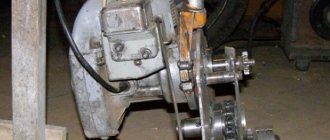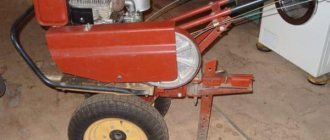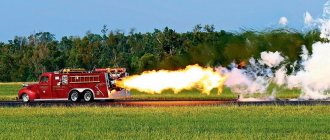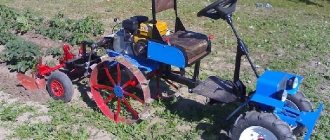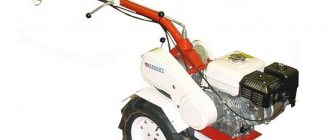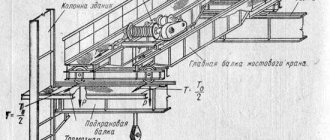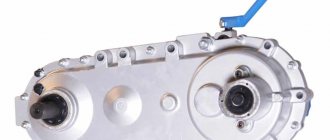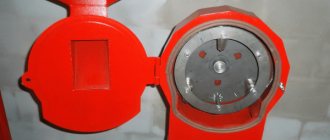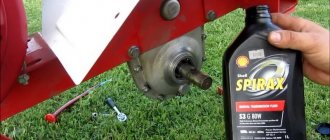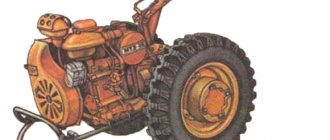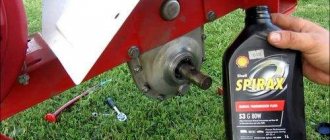What is a gearbox for a walk-behind tractor?
The standard gearbox of a walk-behind tractor is a power unit that transmits torque from the engine and transmission directly to the working shaft on which cutters or wheels are mounted.
It bears a significant power (work) load. Modern walk-behind tractors use different technical solutions for this unit:
- gear transmissions;
- chain;
- worm;
- combined.
The gear housing (housing) is sealed. There is a gasket between the body and the cover. The seal is necessary to retain the oil. All rotating parts of the unit operate in an oil bath.
Located at the bottom of the walk-behind tractor in the center. On cheap models it may be non-separable and cannot be repaired.
DIY gearbox assembly
The operation of walk-behind tractors, and with them gearboxes, means dust, off-road conditions, heat when plowing or cold when clearing snow, uneven loads. You can extend the life of the transmission mechanism by using a closed housing.
Read also: Cutting sheets on a guillotine
ST-40 steel is used for the base on which pulleys, gears, and other parts are mounted. The cover can be made from less durable steel if torque transmission elements are not attached to it.
The use of bearings for installing shafts, pulleys, sprockets, gears is mandatory, otherwise friction will dampen the rotational force, and the unit will either quickly fail or not work immediately.
Any rotating mechanism requires lubrication. Worm gear especially. Frequent replacement of lubricant will help extend the life of the device, for which the gearbox cover must be openable.
Gasoline and diesel engines have regulation of fuel supply and engine speed. It is optimal to move the so-called gas handle to the handle of the walk-behind tractor.
When all the necessary parts have been found, plumbing tools will be required to assemble the walk-behind tractor. You can’t do without a welding machine, grinder, drill, metal drill bits.
The time spent on making a walk-behind tractor will pay for itself completely in the first summer season.
Classification of gearboxes used on walk-behind tractors and their characteristics
Below are the main types of such units that can be found on modern walk-behind tractors.
Angular
This type gets its name because it turns and transmits torque at an angle. Most often at a straight line, 90 degrees. This may be necessary when installing attachments - a rotary snow blower, a header, an active cutter, etc.
Angular gearboxes can be zero, which do not change the speed. And also increasing or decreasing. Overdrives increase the number of revolutions of the output shaft in comparison with the input, which results in a loss of power. Downshifts, on the contrary, reduce the output speed and increase force.
The picture shows an angular gearbox for mounting a snow blower:
The output speed is determined by the needs of the attachment. Where high speeds of the working body are required, booster units are installed. Where low speeds and power are needed, on the contrary, lowering ones are installed.
Downward
The operating principle of all reduction gearboxes is simple: a small gear rotates a larger one in diameter. A larger gear has a larger radial arm. The greater the leverage, the greater the force.
Most gearboxes have several gears that alternately transmit torque to each other. A reduction gear can be any type: worm, gear, chain or combined.
Some engines for walk-behind tractors are equipped from the factory with a reduction gearbox with a gear ratio of approximately 2:1. That is, at the output from the engine shaft, for example, 3600 rpm. At the output from the reduction gear shaft - 1800 rpm. But the rotation force is 2 times greater.
This is the engine in the picture. In the foreground is the cover and shaft of the reduction gearbox for a motor cultivator:
This is a complex mechanism equipped with an automatic (centrifugal) clutch.
But it cannot be considered as some kind of separate special device. This is an integral part of such a motor.
Motoblocks also use other reduction gears, most often homemade.
Gear
These are gearboxes in which rotation is transmitted using gears. Due to the dense and deep engagement of the gear teeth with each other, large power loads are transmitted. Knots of this type are used on the most powerful machines and mechanisms.
Gears are made of special durable steel that is resistant to breakage and abrasion. They rotate in oil, which extends their service life.
The image shows a repair kit, a set of gears for such a gearbox:
Disadvantage of this type: manufacturing high-quality gears with minimal tolerances is a high-tech, expensive process. High-quality gearboxes are expensive. If, in order to reduce the cost, the parts are made of poor quality, the unit does not last long.
Worm
A spiral helical worm gear rotates the gear. At the same time, the speed decreases many times and the force on the output shaft of the gear increases.
The advantages of this solution are simplicity, a minimum of parts, and a rigid grip.
The downside is that with constant rotation, the rubbing surfaces of the spiral and gear teeth wear out quite quickly. Especially if they are made of low-quality alloys and with large tolerances (low accuracy).
The photo shows an example of such a gearbox:
Gearboxes of this type are very suitable for opening gates, covers of industrial equipment, etc., that is, where the mechanism makes a minimum of revolutions. And the revs themselves are low. With constant loads and rotation of the working shaft of the walk-behind tractor, wear can be accelerated.
Purpose of the mechanism
When planning to make an angular gearbox with your own hands, you must first become familiar with the purpose of such a mechanism. It appears to be a special device that converts the torque coming from the engine into driving force.
There are many varieties of this type of device, among which it is advisable to mention the following types:
- gear;
- worm;
- chain;
- combined.
A walk-behind tractor can perform many tasks
. It should be noted that the service life of the power unit, as well as the entire device, directly depends on the quality of such an element, and therefore, a homemade gearbox must be assembled from reliable elements without signs of wear.
What does the speed reducer consist of?
If you want to start assembling this element, you need to study its design, as well as the main components. A gearbox that reduces speed consists of several key components, the list of which can vary significantly and depends on the type of device. In this case, it is necessary to mention several components that seem to be basic:
- input and output shaft mechanism;
- gears - driving and driven;
- worm, its wheel and other parts.
When assembling, it should be remembered that the drive gears and stars provided by the design of the unit have a larger number of teeth than their driven counterparts. Bearings, couplings, and a housing can be used as auxiliary elements in the design, which can protect both the entire mechanism and part of it.
Design and principle of operation
The design and operating principle of the main types of gearboxes are described above. In addition to them, chain gearboxes are used on walk-behind tractors; this design is used on Cascade brand cultivators. They operate with gears, the rotation between which is transmitted using chains. They have reverse.
There are also combined mechanisms. The picture below is gear-chain type:
Criteria for selecting a walk-behind tractor by gearbox type
If the walk-behind tractor is low, it means it is equipped with a gear reducer. This type is compact, so the entire walk-behind tractor and its center of gravity are located noticeably lower than other options.
A low unit is easier to work with. There are no chains that tend to stretch over time, which leads to malfunction. The downside of this option is that it is noisier. And there are problems if the parts of the assembly are made of poor quality, from cheap alloys. In terms of complexity, such a unit is comparable to gearboxes of a car and other machines and units.
The most common type of gearbox on walk-behind tractors is the gear-chain gearbox, shown in the image above. It combines the advantages of a gear and chain gearbox, but has the same general disadvantages - chain stretching. The gearbox is tall, so units with it have a high center of gravity.
Making your own gearbox step by step
It is impossible to make a full-fledged gearbox with a crankcase, axles (shafts) on bearings and sets of gears or chain sprockets on your own. This is a complex assembly that requires a production line with many high-precision machines to produce. Sometimes owners adapt ready-made reduction or angular gearboxes from other machines and mechanisms for their units.
The simplest version of a reduction gear (more precisely, a reduction gear) is shown in the following video:
Chains and chain sprockets from a motorcycle were used here. It is impossible to describe step by step all the actions of such tuning. Main stages:
- In front of the factory gearbox, a homemade stand is placed under the working shaft, on bearings.
- Large gears from a motorcycle, a pair, are attached to the working shaft. One on each side of the rack.
- Small sprockets are mounted on the shaft located in the factory gearbox.
- Chains are stretched between the sprockets, like on a motorcycle.
The design must include a device for adjusting chain tension.
Angular reverse gear unit
This is one of the effective gearboxes. Its task is to ensure that the transmission is connected to the engine. The owner can improve the angular gearbox himself, which will help increase the power of the gearbox. The mechanism consists of:
- generator housing;
- flange;
- flange mounting;
- keys and steel washer;
- pulley fastening;
- a pulley that has a V-belt drive;
- rotor shaft;
- flange bearing.
To design a bevel gearbox, you don’t need a lot of knowledge. Even minimal skills in its manufacture are acceptable here.
Model range of gearboxes for walk-behind tractors
All gearboxes of the above types are on sale. When choosing a new gearbox, you should first of all take into account compatibility - the unit must simply match the specific model in terms of dimensions, mountings, and gear ratio. At the same time, the specificity of modern walk-behind tractors is that the same model can have both different engines and gearboxes.
For example, let’s compare the well-known and popular Russian walk-behind tractor Neva MB2 with the traditional and new Multiagro gearbox.
Traditional gearbox:
- unlocking on one wheel . When rotating, one wheel is easy to turn in only one direction;
- gear shifting on the gearbox cover , which is inconvenient when traveling with a trolley. You have to stop, get off the cart and approach the walk-behind tractor to change gears;
- 2 forward speeds, 1 reverse speed . If you transfer the transmission belt to pulleys with a different gear ratio, the number of speeds doubles. As a result, 4 speeds forward, 2 reverse.
New Multiagro gearbox:
- two wheel unlocking . The left and right locking handles are located on the steering wheel. With their help it is easy to turn in both directions, and not in one;
- gear shifting using a cable is moved from the gearbox housing to the steering wheel, which is convenient;
- more gears: 3 forward, 2 reverse . When throwing the belt 6 forward 2 back.
It is still difficult to compare the reliability and service life of these different models. The new unit has been on sale relatively recently, approximately since 2022. But it was developed and tested for quite a long time. In terms of functionality and convenience, Multiagro has a clear superiority. This is a Russian production, St. Petersburg, .
Cross-section of the Multiagro gearbox:
A gearbox with gear switching on a walk-behind tractor essentially gives only advantages; it is a kind of analogue of a car’s gearbox. This is the responsible node. If performed well, it can have a fairly long service life. The main thing that depends on the owner to extend the service life of such units is the smooth activation of speeds, control over the quantity and quality of oil.
